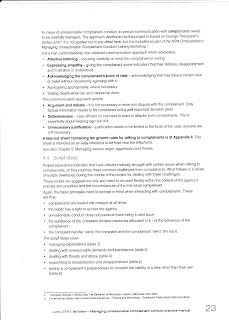- ACN 079 638 501 Pty Ltd v Pattison
This is the corrupt trustee Paul Pattison that was protected by Veronique Ingram and senior management at ITSAUp one level
- who owns the WIP.
Summary
An insolvency practice was operated
through a company controlled by an insolvency practitioner. The Court
made a finding that because of the particular arrangements between the
company and the practitioner the work in progress was an asset belonging
to the company. Accordingly, the court made a declaration that on the
facts in this case work in progress is an asset of the Company. As the
company had charged its assets in favour of a bank and the bank had
appointed a Receiver the charge was enforceable by that Receiver.
Facts:
Mr Pattison operated his practice
through the Company. The time spent by Mr Pattison was included in the
Company’s invoice and no separate charge was made by Mr Pattison
personally. Wages were payable to Mr Pattison as an employee. The
Company had charged its assets in favour of the Bank of Western
Australia (‘Bankwest’).
As part of the process of placing
the Company into a members’ voluntary liquidation in April 2010 Mr
Pattison’s declaration on solvency included the work in progress as an
asset of the company and valued at $4.1million (as against $6.3 million
recorded – the reduction based on his assessment of what could
realistically be recovered).Issue: Was the work in progress an asset of the Company, and hence subject to the Bankwest charge, or the property of Mr Pattison?
Decision:
The court considered the real
question was the relationship between Mr Pattison and the Company and
the effect that had on the ownership of the work in progress. Ferguson J
accepted that:
There is no doubt that Mr Pattison had
certain obligations arising from the appointment of him personally as
liquidator, administrator or trustee in bankruptcy. However, that is not
determinative of the ownership of the work in progress as between Mr
Pattison and the Company.The Court turned to consider whether Mr Pattison was an employee of the Company as the Receivers contended. Mr Pattison argued on the other hand the Company provided services to him and the arrangements for reimbursement could be terminated by him at any time without notice or penalty, presumably with the effect that any amounts due for work in progress reverted to him and were due to him as a personal liability. He referred to s165(1)(b) in support of this proposition, as this provision prohibits a trustee making an arrangement to give up a part of remuneration due to the trustee to any other person.
Citing Re Dare (1992) 38 FCR 356 for the proposition that being an employee is not necessarily incompatible with being registered as a trustee in bankruptcy, the court endorsed the proposition that what is of primary importance is whether the employee when acting as a trustee would enjoy ‘independence from external control’.
The Court noted that the fact that nothing prevented Mr Pattison from being an employee and at the same time accepting appointments, and nor did being a director of the Company prevent him from also being an employee of the Company.
In finding Mr Pattison was an employee Ferguson J took the following indicia into account:
i. The Company's books recorded Mr Pattison as an employee
ii. The work he performed went beyond which a Director would perform
iii. That work was recorded as work of the Company
iv.
There was no separate work that was performed on the administrations
that was recorded separately or for which a separate charge was made by
him
v. The full amount of the fees charged was paid to the Company
vi.
Mr Pattison did not seem to deduct any amount or receive payment of any
part of the fees before the payment was made to the Company.
vii.
Mr Pattison received from the Company amounts for that work that
replicated wages rather than payment of the hourly fees charged for his
time working on the administrations.
viii.
The Company’s ownership of the work in progress was made clear in his
Declaration in April 2010, which was consistent with his status as an
employee, and the fiduciary duties not to profit from their position as
director or employee at the expense of the Company, and to account for
property received on behalf of the Company employer.
The
court rejected the submission that the payments to the Company were
reimbursement for services provided and instead concluded that Mr
Pattison was ‘merely a conduit for payment for the money to the
Company’.The Court went on to hold that the work performed by Mr Pattison was an asset of the Company, the ‘time records’ being ‘akin to an inventory record for stock’. It only remained for the court to confirm that the charging provision was broad enough to capture the work in progress and that it was therefore enforceable by the Receivers appointed by Bankwest.
Note: Appeal application lodged in the Victorian Supreme Court decision by Mr Pattison - no hearing date has been advised yet.
















































































